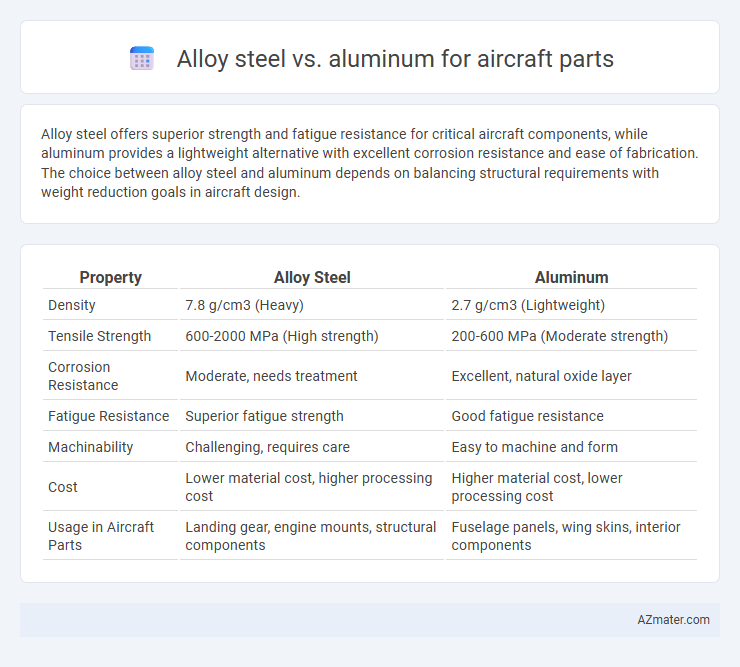Alloy steel offers superior strength and fatigue resistance for critical aircraft components, while aluminum provides a lightweight alternative with excellent corrosion resistance and ease of fabrication. The choice between alloy steel and aluminum depends on balancing structural requirements with weight reduction goals in aircraft design.
Table of Comparison
| Property | Alloy Steel | Aluminum |
|---|---|---|
| Density | 7.8 g/cm3 (Heavy) | 2.7 g/cm3 (Lightweight) |
| Tensile Strength | 600-2000 MPa (High strength) | 200-600 MPa (Moderate strength) |
| Corrosion Resistance | Moderate, needs treatment | Excellent, natural oxide layer |
| Fatigue Resistance | Superior fatigue strength | Good fatigue resistance |
| Machinability | Challenging, requires care | Easy to machine and form |
| Cost | Lower material cost, higher processing cost | Higher material cost, lower processing cost |
| Usage in Aircraft Parts | Landing gear, engine mounts, structural components | Fuselage panels, wing skins, interior components |
Introduction to Aircraft Materials
Alloy steel offers exceptional strength and fatigue resistance essential for high-stress aircraft components such as landing gear and engine mounts, while aluminum provides lightweight advantages critical for overall fuel efficiency and airframe structures. The density of aluminum, approximately 2.7 g/cm3, significantly reduces aircraft weight compared to alloy steel's density of about 7.8 g/cm3, influencing performance and payload capacity. Selecting materials balances mechanical properties, corrosion resistance, and weight, with aluminum alloys commonly used in fuselage and wing assemblies, whereas alloy steel is preferred in sections demanding superior tensile strength and wear resistance.
Key Properties of Alloy Steel
Alloy steel is favored in aircraft parts for its exceptional strength, high tensile resistance, and excellent fatigue durability, making it suitable for critical structural components. It offers superior hardness and wear resistance compared to aluminum, enhancing the longevity of parts exposed to intense mechanical stresses. The material's thermal stability and resistance to corrosion also ensure reliable performance under extreme temperatures and demanding operational conditions.
Key Properties of Aluminum
Aluminum is prized in aircraft parts for its exceptional strength-to-weight ratio, corrosion resistance, and excellent thermal conductivity, making it ideal for lightweight and durable components. Its high malleability and resistance to fatigue enhance manufacturing efficiency and longevity in aerospace applications. Compared to alloy steel, aluminum significantly reduces overall aircraft weight, improving fuel efficiency and performance without compromising structural integrity.
Weight Considerations in Aircraft Design
Alloy steel offers superior strength and durability but has a significantly higher density of about 7.85 g/cm3 compared to aluminum's lighter 2.70 g/cm3, making aluminum the preferred choice for weight-sensitive aircraft parts. The reduced weight of aluminum contributes to improved fuel efficiency and increased payload capacity, critical factors in aircraft performance optimization. Although alloy steel provides better wear resistance and strength, aluminum's favorable strength-to-weight ratio is essential for maintaining aircraft structural integrity while minimizing overall weight.
Strength and Durability Comparison
Alloy steel exhibits significantly higher tensile strength and fatigue resistance compared to aluminum, making it ideal for critical aircraft components subjected to extreme stress. Its superior durability ensures longer service life under harsh operational conditions, reducing maintenance frequency and enhancing safety. Aluminum, while lighter and corrosion-resistant, generally lacks the strength and wear resistance of alloy steel, limiting its use to less structurally demanding parts.
Corrosion Resistance and Maintenance
Alloy steel offers superior strength but requires frequent maintenance due to its susceptibility to corrosion, especially in harsh environments. Aluminum provides excellent corrosion resistance, reducing the need for protective coatings and extensive upkeep, making it ideal for aircraft parts exposed to moisture and salt air. This corrosion resistance significantly lowers long-term maintenance costs and enhances the durability of aluminum components in aerospace applications.
Cost Analysis and Availability
Alloy steel for aircraft parts offers high strength and durability but comes with higher costs due to complex manufacturing and material prices, whereas aluminum is more cost-effective and widely available, making it ideal for large-scale production. Aluminum's abundance and ease of machining reduce overall expenses and lead times, despite its lower strength compared to alloy steel. The choice depends on budget constraints and performance requirements, with aluminum preferred for cost-sensitive applications and alloy steel for high-stress components.
Machinability and Fabrication Differences
Alloy steel offers superior strength and wear resistance but presents challenges in machinability due to its hardness and tendency for tool wear, requiring specialized cutting tools and slower machining speeds compared to aluminum. Aluminum excels in machinability with ease of cutting, forming, and welding, resulting in faster fabrication and reduced tooling costs while maintaining lightweight properties ideal for aircraft parts. Fabrication of alloy steel parts often involves heat treatment and more complex machining processes, whereas aluminum parts benefit from simpler processes and corrosion-resistant surface treatments.
Application Examples in Aircraft Parts
Alloy steel is commonly used in aircraft landing gear and engine components due to its high strength, toughness, and resistance to fatigue under extreme stress. Aluminum, favored for its lightweight and excellent corrosion resistance, is extensively applied in airframe structures such as fuselage skins, wing panels, and control surfaces to enhance overall fuel efficiency. Specific examples include 300M alloy steel in landing gear assemblies and 2024 or 7075 aluminum alloys in wing skins and aircraft frames.
Choosing the Right Material for Aircraft Parts
Alloy steel offers superior strength and fatigue resistance compared to aluminum, making it ideal for high-stress aircraft components such as landing gear and engine parts. Aluminum, with its lower density and excellent corrosion resistance, is preferred for lightweight structural elements like fuselage panels and wing skins to improve fuel efficiency. Selecting the right material involves balancing strength-to-weight ratio, durability, and specific component requirements to ensure optimal aircraft performance and safety.

Infographic: Alloy steel vs Aluminum for Aircraft part
 azmater.com
azmater.com